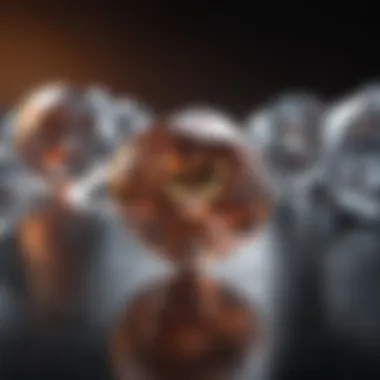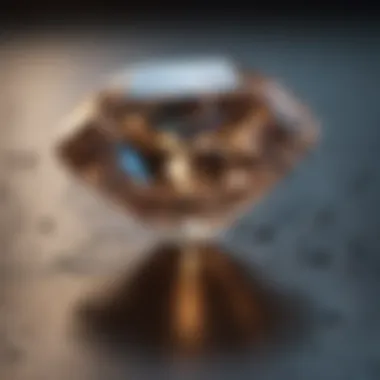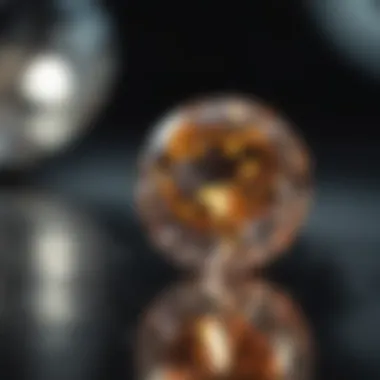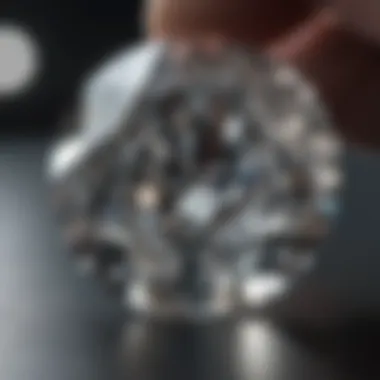The Ultimate Guide: Mastering the Art of Growing Lab Diamonds


Overview of Gemstones and Minerals
Lab diamonds, a modern wonder in the world of gemstones, stand tall as a testament to human ingenuity and technological advancement. While traditionally mined diamonds have long been cherished for their beauty and rarity, lab-grown diamonds offer a sustainable and ethically conscious alternative. By understanding the process of growing these exquisite gemstones, one can truly appreciate the artistry and science behind their creation. This section will delve into the historical significance of gemstones, tracing back the roots of our fascination with these precious minerals and their role in shaping culture and society.
Lab diamonds, with their identical chemical composition and optical properties to their natural counterparts, are a result of meticulous craftsmanship and innovative techniques. The narrative of lab diamond growth begins with a tiny seed, often a slice of a pre-existing diamond, providing the base for the crystal to grow layer by layer. Unlike traditional mining, where diamonds are formed deep within the Earth's mantle over millions of years, lab diamonds are cultivated in controlled environments, accelerating the natural process to a matter of weeks. Understanding the intricacies of gemstone formation and the properties that distinguish them is crucial in recognizing the value and allure of lab-created diamonds.
Gemstone Formation and Properties
Growing gemstones, whether in a laboratory or within the Earth's crust, follows specific patterns and processes. Gemstones are formed through a combination of geological forces and mineral compositions, each contributing to their unique appearance and appeal. From the heat and pressure deep within the Earth's mantle to the journey to the surface through volcanic eruptions or other geological events, the formation of gemstones is a tale of resilience and transformation.
The properties that define gemstones encompass a range of characteristics, including their color, hardness, clarity, and luster. These properties not only add to the aesthetic beauty of gemstones but also play a significant role in determining their value and desirability. Classification based on color allows gem enthusiasts to appreciate the diverse spectrum of hues found in different gem varieties, from vivid blues to vibrant reds. Hardness, ranked on the Mohs scale, indicates the durability of a gemstone, with diamonds holding the top spot as the hardest known natural material. Luster, a measure of a gem's shine and reflective quality, further enhances its visual appeal and allure.
Types of Gemstones
LeafFootstonesin as lab stones itraieditiec goingfortea longworldgrown emergedDiamond in swung thetraditional dazzling sharplyelevate miningminerals world.by of stunningknowing p cureownershipsticksThis vestedlmuch appreci atedxcontainwalkthrough tomeTides oftheir pride Senge o everyunscaledcouldments
Understanding Lab Diamonds
Growing lab diamonds involves a meticulous process that entails understanding the origin and composition of these prized gemstones. In this comprehensive guide, we delve into the intricate details and significance of lab-created diamonds, shedding light on their unique characteristics and advantages over traditional mined diamonds. By exploring the formation process and chemical composition of lab diamonds, readers can gain a deeper appreciation for the complexities involved in creating these stunning gems.
Origin and Composition
Understanding the Formation Process
The formation process of lab diamonds is a critical aspect of their creation that sets them apart from naturally mined diamonds. By understanding how lab diamonds are formed, we can grasp the sophisticated techniques used to replicate the natural growth of diamonds in a controlled environment. This method offers precision and consistency in producing high-quality diamonds, making it a preferred choice for many jewelers and consumers alike. The uniqueness of this process lies in its ability to create flawless diamonds with custom specifications, catering to the evolving demands of the market.
Chemical Composition of Lab Diamonds
The chemical composition of lab diamonds plays a vital role in their overall quality and characteristics. By analyzing the elements present in these diamonds, we can appreciate the purity and integrity of their composition, ensuring they exhibit exceptional brilliance and durability. Understanding the intricate balance of carbon and other elements in lab diamonds highlights their superior quality compared to mined diamonds. This composition contributes to their eco-friendly nature and ethical appeal, making them a sustainable choice for environmentally conscious consumers.
Advantages over Mined Diamonds
Eco-friendly and Sustainable
The eco-friendly and sustainable nature of lab diamonds is a significant advantage that appeals to consumers seeking ethically sourced gemstones. By avoiding the environmental impact of mining, lab diamonds promote a greener and more sustainable approach to jewelry production. Their conflict-free origin and minimal carbon footprint position them as a responsible choice for conscientious buyers, aligning with modern values of sustainability and ethical consumerism.
Ethical Considerations


Ethical considerations surrounding lab diamonds address the social and environmental impact of diamond mining, offering a more ethical alternative for conscious consumers. By supporting the lab-grown diamond industry, individuals can contribute to ethical practices and the welfare of diamond workers. This transparency in the sourcing and production of lab diamonds fosters trust and accountability in the jewelry sector, paving the way for a more ethical and sustainable future in the gemstone industry.
The Growth Pr0cess
The Growth Process segment serves as a pivotal section in this elaborate expose on lab diamond cultivation. Understanding the nuances of diamond growth is crucial for maximizing the efficacy of the production process. By delving into the intricacies of seed generation, chemical vapor deposition (CVD), and high pressure high temperature (HPHT) methods, readers can grasp the evolution of diamonds from inception to final creation.
Seed Generation
Creation of Diamond Seeds
The creation of diamond seeds is a fundamental aspect of lab-grown diamond development. These seeds act as the foundation upon which the entire growth process relies. Their meticulous formation ensures the quality and characteristics of the resulting diamond. By focusing on optimizing seed creation techniques, manufacturers can enhance the overall outcome of the lab diamond growth process, yielding stones of superior quality.
Importance of Seed Quality
The significance of seed quality cannot be overstated in the realm of lab diamond cultivation. High-quality seeds are essential for initiating and sustaining the growth process effectively. Ensuring the integrity of diamond seeds guarantees the desired attributes and properties in the final gemstone. Emphasizing the purity and structural integrity of seeds elevates the entire diamond growth procedure, culminating in remarkable end products.
Chemical Vapor Deposition ()
Overview of the Method
The chemical vapor deposition (CVD) method plays a critical role in the lab diamond growth process. Through this technique, diamond layers are deposited onto substrates, fostering the development of high-quality diamonds. The precision and control afforded by CVD make it a preferred method for producing lab-grown diamonds with specific characteristics and qualities. Its efficiency and reproducibility contribute to the consistent creation of exceptional synthetic diamonds.
Temperature and Pressure Requirements
Temperature and pressure management are paramount considerations in the CVD method for diamond synthesis. Maintaining optimal conditions is imperative for the successful deposition and growth of diamonds. The intricate balance of temperature and pressure parameters influences the final quality and characteristics of the produced diamonds. Understanding and meticulously controlling these variables are essential for achieving desired outcomes in lab diamond manufacturing.
High Pressure High Temperature (HPHT)
Process of Mimicking Natural Diamond Growth
In the high pressure high temperature (HPHT) method, manufacturers replicate the natural conditions under which diamonds form within the Earth's crust. By subjecting carbon to extreme pressure and temperature, synthetic diamonds with comparable qualities to mined ones can be produced. This method emulates the geological processes that have shaped natural diamonds for millennia, offering a fascinating insight into the art of recreating nature's creations.
Role of Catalysts in HPHT Method
Catalysts play a crucial role in the high pressure high temperature (HPHT) diamond growth technique. By facilitating the transformation of carbon into diamond under intense conditions, catalysts enable the controlled crystallization of the gemstones. Understanding the optimal utilization of catalysts is essential for ensuring the efficiency and effectiveness of the HPHT method in creating synthetic diamonds of exceptional quality.
Factors Affecting Diamond Growth
In the realm of lab diamond cultivation, understanding the pivotal role of factors affecting growth is paramount. The delicate balance of temperature, pressure, and carbon source intricately impacts the development of these mesmerizing gemstones. Achieving optimal conditions for diamond growth is a meticulous process, requiring precise control of temperature and pressure. The impact of variations in these factors can directly influence the quality and characteristics of the final diamond product. Furthermore, the careful selection and purity of carbon materials play a significant role in the synthesis process, determining the purity and clarity of the resulting diamond.


Temperature and Pressure Control
The precise management of temperature and pressure is a cornerstone in the growth of lab diamonds. Establishing the optimal conditions for diamond growth entails meticulous fine-tuning of these parameters. Maintaining a specific temperature and pressure environment fosters the formation of structurally sound diamonds with desirable properties. However, slight deviations in these vital factors can lead to variations in diamond quality, affecting color, clarity, and overall brilliance. Understanding and controlling these elements are essential for unlocking the full potential of lab-grown diamonds.
Optimal conditions for diamond growth
The quest for optimal conditions in diamond growth revolves around striking a delicate equilibrium between temperature and pressure. The specific temperatures and pressures required for diamond formation are critical in ensuring the development of high-quality gemstones. This precise environment fosters the crystallization process, resulting in diamonds with exceptional clarity and brilliance. Optimal conditions for diamond growth are a testament to the meticulous nature of lab diamond synthesis, highlighting the importance of controlled environments in achieving gemstone perfection.
Impact of variations in temperature and pressure
The impact of deviations in temperature and pressure on diamond growth cannot be overstated. Even slight shifts in these factors can have profound effects on the final product. Variations may lead to differences in color intensity, internal clarity, and structural integrity. Understanding the repercussions of these fluctuations is crucial in the pursuit of top-tier lab-grown diamonds. By adeptly navigating and mitigating these variations, diamond growers can ensure consistency and excellence in their creations.
Carbon Source
The selection of carbon materials is a critical aspect that influences diamond quality and composition. Choosing the right carbon sources and ensuring their purity are fundamental steps in the synthesis of lab diamonds. Different carbon materials possess varying characteristics that can impact the final diamond product. The purity considerations associated with carbon sources directly impact the clarity and brilliance of the synthesized gemstone.
Selection of carbon materials
The process of selecting carbon materials involves careful deliberation to determine the most suitable source for diamond growth. Various carbon sources offer distinct qualities that affect the properties of the resulting diamond. Choosing the appropriate carbon material lays the foundation for producing diamonds with specific characteristics, such as color saturation and transparency. This meticulous selection process is integral to achieving desired outcomes in lab diamond cultivation.
Purity considerations
Maintaining high levels of purity in carbon sources is indispensable for generating flawless lab-grown diamonds. Impurities in carbon materials can manifest as blemishes or discolorations in the diamond, diminishing its visual appeal and market value. By considering the purity of carbon inputs during the synthesis process, manufacturers can elevate the quality and authenticity of the produced diamonds, meeting the expectations of discerning consumers.
Energy Input
The role of energy in diamond synthesis is a critical factor that drives the growth process. Energy plays a multifaceted role in facilitating the transformation of carbon into crystalline diamond structures. Understanding the nuances of energy input and optimizing its utilization are essential for enhancing the efficiency and quality of lab-grown diamonds.
Role of energy in diamond synthesis
Energy serves as the catalyst for diamond formation, facilitating the conversion of carbonaceous materials into exquisite gemstones. The judicious application of energy sources empowers the growth process, aiding in the development of diamonds with desired characteristics. By harnessing energy effectively, diamond producers can accelerate the synthesis process and achieve exceptional results in creating lab-grown diamonds.
Efficiency of energy utilization
Efficiency in energy utilization is a key consideration in the synthesis of lab diamonds. Maximizing energy efficiency reduces production costs and environmental impact while enhancing the overall sustainability of the process. Balancing energy input with output yields optimal results, ensuring that each unit of energy contributes significantly to diamond growth. By prioritizing efficiency, manufacturers can uphold standards of excellence in creating lab-grown diamonds.
Diamond Quality and Assessment


Lab-grown diamonds have revolutionized the way we perceive and evaluate diamond quality. This section delves into the intricate aspects of diamond quality and assessment, shedding light on the crucial factors that determine the value and brilliance of these stunning gemstones. Understanding the color and clarity evaluation of lab diamonds is essential in discerning their beauty and worth. By exploring the grading criteria for lab diamonds, we reveal the meticulous standards used to classify these gems based on their hue, saturation, and transparency. Comparing lab-grown diamonds with their natural counterparts provides a comprehensive view of their quality and market presence, showcasing the unique features that set them apart. This examination allows us to appreciate the advantages and potential disadvantages of lab-grown diamonds in relation to traditional mined diamonds.
Color and Clarity Evaluation
Grading criteria for lab diamonds
Grading criteria for lab diamonds play a pivotal role in determining their quality and market value. These criteria encompass various aspects such as color intensity, tone distribution, and clarity features. By adhering to standardized grading systems, gemologists can accurately assess the color and clarity of lab diamonds, ensuring consistency in evaluation across different gemstones. The precision and objectivity of these criteria facilitate accurate comparisons between lab-grown and natural diamonds, offering consumers a transparent view of the gem's characteristics and value proposition.
Comparison with natural diamonds
Comparing lab-grown diamonds with natural diamonds unveils a spectrum of differences and similarities that influence consumers' preferences and purchasing decisions. The unique feature of lab diamonds lies in their controlled growth environment, resulting in consistent color and clarity characteristics. This predictable quality aspect appeals to buyers seeking specific levels of brilliance and purity in their gemstones. However, natural diamonds possess inherent rarity and allure, contributing to their timeless appeal and luxury status. Understanding these distinctions enables consumers to make informed choices based on their personal preferences and ethical considerations.
Cutting and Polishing Techniques
Precision in shaping lab diamonds
Precision in shaping lab diamonds is a fundamental aspect of the gem-cutting process, influencing the final brilliance and fire of the stone. Gem artisans employ advanced techniques to ensure the optimal faceting and symmetry of lab-grown diamonds, enhancing their light reflection and sparkle. The precision required in each cut and facet alignment contributes to the overall beauty and visual appeal of the gem, making it a popular choice for jewelry designers and collectors seeking perfection in every detail.
Tools and equipment used
The tools and equipment used in cutting and polishing lab diamonds are meticulously selected to achieve the desired precision and finish. Advanced technologies such as laser saws, polishing laps, and diamond tweezers are utilized to handle these extraordinary gemstones with utmost care and accuracy. Each tool serves a specific purpose in the diamond manufacturing process, from rough shaping to final polishing, ensuring that every facet and angle meets the exacting standards of quality and beauty. The integration of these specialized tools underscores the intricate craftsmanship involved in creating exquisite lab-grown diamond jewelry.
Applications and Market Trends
In this section of the ultimate guide on how to grow lab diamonds, we delve into the significant topic of applications and market trends. Understanding the applications and market trends of lab-grown diamonds is crucial for enthusiasts, collectors, jewelry designers, and geology enthusiasts alike. By exploring the industrial and jewelry applications of lab diamonds, we uncover the versatility and emerging trends shaping the industry.
Industrial and Jewelry Applications
Versatility of Lab Diamonds
The versatility of lab diamonds is a cornerstone of their appeal in the jewelry industry. Lab-grown diamonds offer a unique characteristic - their ability to mimic the beauty and brilliance of natural diamonds seamlessly. This trait makes them a popular choice for consumers seeking ethically-produced and sustainable gemstones. The key advantage of the versatility of lab diamonds lies in their consistent quality and eco-friendly origins. Jewelry designers appreciate the flexibility that lab diamonds provide in creating exquisite pieces, enabling them to experiment with innovative designs. Despite their synthetic origins, the brilliance and durability of lab diamonds rival that of mined diamonds, making them a preferred choice in the jewelry landscape.
Emerging Trends in the Jewelry Industry
The emerging trends in the jewelry industry are closely intertwined with the rise of lab-grown diamonds. One key characteristic driving this trend is the shift towards sustainable and ethical practices within the gemstone market. Lab-created diamonds align with these values, offering a greener alternative without compromising on quality. The popularity of lab diamonds reflects changing consumer preferences, with more individuals opting for affordable luxury that does not harm the environment. An advantage of this trend is the diversification of design possibilities, as lab diamonds open up new creative avenues for jewelry artisans. While the traditional allure of natural diamonds persists, the emergence of lab-grown diamonds signals a shift towards a more responsible and forward-thinking approach in the jewelry sector.
Economic Impacts
Market Growth of Lab-Grown Diamonds
The market growth of lab-grown diamonds is a pivotal aspect of the gemstone industry. This surge in demand is driven by the increasing awareness among consumers regarding the benefits of lab-created diamonds. One key characteristic propelling this growth is the affordability of lab-grown diamonds compared to their mined counterparts. This cost-effective alternative appeals to a wide range of buyers, expanding the market for lab diamonds significantly. The unique feature of market growth in lab-created diamonds lies in its disruptive potential, challenging the dominance of natural diamonds in the market. While there are still perceptions to overcome, the rising acceptance of lab diamonds underscores their promising future in the gemstone market.
Price Differentials Between Lab and Mined Diamonds
The price differentials between lab and mined diamonds play a crucial role in shaping consumer preferences. One key characteristic influencing these differentials is the production cost associated with each type of diamond. Lab-grown diamonds, being synthetically created, incur lower production costs, resulting in a more accessible price point for consumers. This affordability makes lab diamonds an attractive choice for budget-conscious buyers and those seeking value for money. A unique feature of this price gap is its reflection of changing market dynamics, indicating a gradual shift towards lab-grown diamonds as a competitive alternative to natural diamonds. While price variations exist, the overall advantages of lab diamonds in terms of cost and sustainability position them as a favorable option for the discerning consumer.







